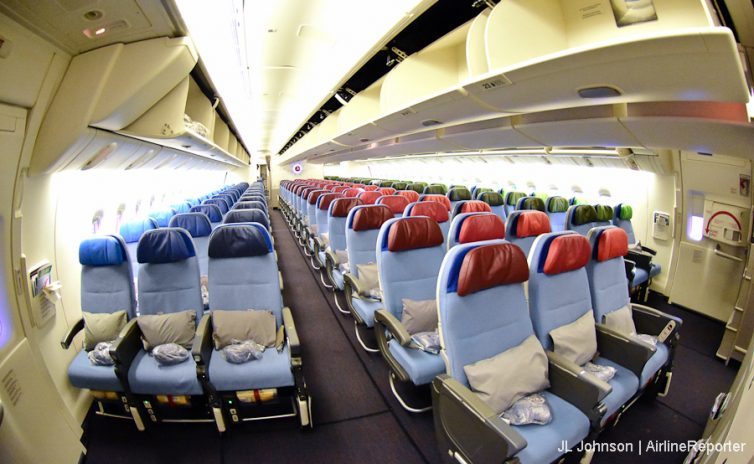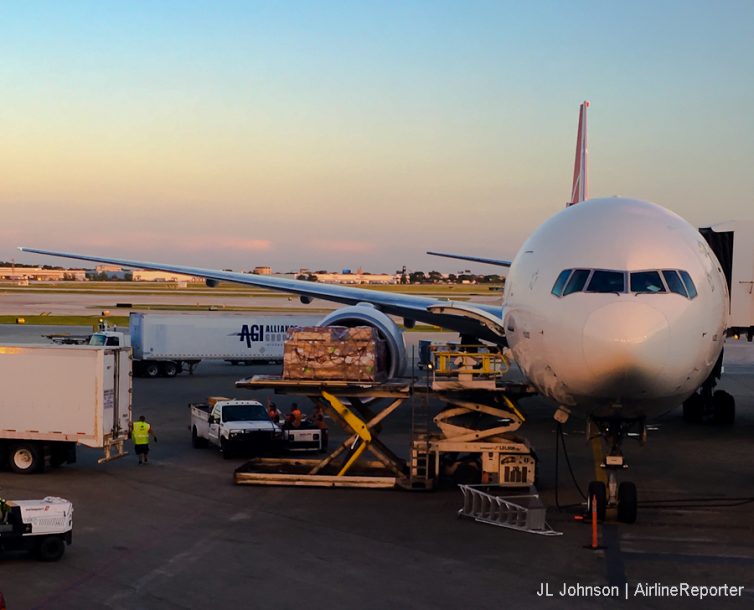Just recently I wrote about my business class experience from Chicago to Istanbul. After just two full days on the ground in beautiful and historic Istanbul, it was time to head home. I was still beaming from the “wow factor” I had on the nine-hour flight in, and had high hopes that I might secure a battlefield upgrade for a second time. Sadly, fate was not in my favor and I would be taking the eleven-hour transatlantic trek in the second-to-last row of an almost full 777-300ER. Bad news for me, good news for our editors, and you, our loyal readers. You want more economy class reviews? You got it!

My Lufthansa flight from Frankfurt to Hamburg
I am one lucky guy. I have never had a bag lost by an airline before. Well, before my recent trip to Hamburg, Germany for Airbus Innovations Days. “Um, you are going to tell us a story about your bag David?” Heck yes; stick with me here.
I try not to check my bag. Ever. I have it down to a science how to pack my little rollaboard, get it up in the bin, and call it good. So why did I give in? A few reasons. First off, it was free. Secondly, I had a 55-minute layover in Frankfurt and knew I was going from one side of the airport to the other. Rolly McRollerson was going to slow me down. I figured “why not?” Yeah, my bad.

My Condor Boeing 767 in Seattle – Photo: David Parker Brown | AirlineReporter
I remember clearly handing my bag to the ticket agent in Seattle, her placing a pink “priority” tag on him, and off my bag went. And then yadda yadda yadda, I landed in Frankfurt. I hauled across the airport thinking I made the right call checking my bag, and got to my gate to see my flight was 30 minutes delayed. Heh. I was already on a tight schedule. I needed to get to Hamburg, to the hotel, and then to a dinner hosted by Airbus. I didn’t want to be rude to my hosts.
Then, I rode on my A320 and after I was sitting at the carousel in Hamburg waiting for my bag to arrive. Round and round bags go, mine was surely a no-show (yes, I am proud of myself for that rhyme). Now what? Seriously. I write about airlines and I wasn’t even sure what I was supposed to do next. Isn’t there a counter or something for me to go to? Surely there had to be — but would they speak English?

I am flying to downtown Seattle in an R44 – Photo: Kassy Coan
A few years ago, during my transition between software engineering at Google and program management at Microsoft, I took an intro flight in a Robinson 22 helicopter, simply because there was a good deal going, and it sounded like an adventure. I instantly fell in love with the challenge of flying, was mesmerized by the aerodynamics of it all, and was enthralled by the thought of how to improve the user experience of the pilot and optimize the process of flight.
Here I am, many years later, thinking that was the most expensive $70 Groupon I’ve ever come across! However, I’m now an FAA-rated private helicopter pilot, with 150+ total flight hours between the S300, R22, and R44, and have started working on my fixed wing add-on.
I’m often asked if I’ll ever take up piloting as a career. When I say this isn’t likely, but I plan to invest in it further as a hobby, the looks I get vary from ’œwhy are you wasting your time’ to ’œhow is it worth it financially?’ The same goes for anyone looking at my resume (or that of other aviators); those who haven’t experienced aviation training don’t immediately see how the skills it takes to fly an aircraft apply to improving various aspects of life and other non-aviation-related career skills.
Here are a few of the skills I gained while getting my private pilot license, which help me every day in my personal and professional life:

Main business cabin on the Swiss 777-300ER
On June 10, Swiss International Air Lines officially inaugurated its new Boeing 777-300ER (77W) on its first regularly scheduled daily service to the United States. The debut flight took off from Zà¼rich/Kloten Airport (ZRH) and arrived at Los Angeles International Airport (LAX). The 77W is the first Boeing product in Swiss’s mainly-Airbus fleet, and carries 55% more passengers than the Airbus A340-300 (343) it replaces on the ZRH-LAX route. Its first 77W, HB-JNA (delivered on January 29) with its special “Faces of SWISS” livery, made the flight.
Swiss gave the public a CGI-based video preview of the all-new aircraft and completely redesigned interior, and AirlineReporter was the first to confirm the delivery date of HB-JNA. We were also one of the few media to be invited to LAX for the inaugural events to take a look with our own eyes. Were we disappointed?
Turkish Airlines is, or should be, well known amongst AvGeeks for their hospitality and commitment to passenger experience. The airline has positioned itself as a “European carrier” which might raise eyebrows to those in the West. Most would reasonably assume Turkey to be a resident of an ambiguous neighborhood we Westerners label as the “Middle East.” For what it’s worth, about half of Istanbul, including the airport, the airline’s headquarters, and various operations are indeed on the European continent. Turkey, as it turns out, is a country divided between two continents, giving real meaning to the phrase “East meets West.” The European side is separated from the majority of the country (the Asian side) by a naturally occurring strait referred to as the Bosporus.
Why does all of this matter? Because it gives Turkish Airlines a competitive advantage. It’s easier to go after the European carriers than try to compete in terms of obscenely lavish passenger experience offered by the big three Middle East airlines (ME3). And, let’s be honest. When we think of European carriers, is an overwhelming commitment to passenger experience something that comes to mind? Likely not. It is no wonder then that Turkish Airlines maintains the title of Best Airline in Europe, according to Skytrax.
So how does Turkish differentiate itself from the pack? By offering reasonably priced fares bundled with excellent service and gourmet food. Gourmet food on a plane? Some might think those concepts are mutually exclusive. I beg to differ…



